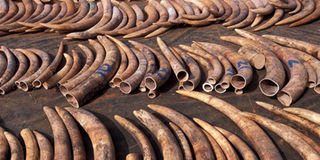Chilling facts on elephant poaching

What you need to know:
Scientists were able to locate the hotspots by matching the DNA fingerprint of seized ivory to DNA profiles from the dung of elephants living throughout the continent, the BBC reported yesterday.
Dar es Salaam. A new scientific way of tracking poaching trends in Africa has shown that Tanzania is amongst the continent’s two leading killers of elephants.
Scientists were able to locate the hotspots by matching the DNA fingerprint of seized ivory to DNA profiles from the dung of elephants living throughout the continent, the BBC reported yesterday.
“The worst area for poaching was identified as Tanzania and nearby parts of Mozambique.”
Around 50,000 elephants are thought to be poached each year. The Tridom, which spans parts of Gabon, the Democratic Republic of Congo and Cameroon, was also highlighted.
African elephants have an estimated population of half a million. Most illegally-poached ivory can be traced back to just these two areas of Africa. The researchers say the data, published in Science journal, may increase international pressure to stop the killing.
This week, the US government hopes to send out a message against the illicit sale of elephant ivory by destroying one tonne of elephant ivory in New York’s Times Square.
The Convention on International Trade in Endangered Species of Wild Fauna and Flora (Cites) banned the international trade in ivory in 1989, but a black market trade continues to thrive.
Ivory is used for trinkets, souvenirs and also in traditional medicines.
With an estimated population of less than half a million, the ongoing African poaching is rapidly driving the animal towards extinction.
International efforts to try to stop the ivory pipeline focuses on points of sale and tightening up controls at potential shipping routes.
But, Dr Samuel Wasser, a conservation biologist from the University of Washington and lead researcher on the Science paper, thinks other measures might be more effective.
“The source populations are where it all starts, and to be able to focus on the source populations, especially the major source populations, is very very effective at trying to target these killings,” Dr Wasser told the BBC’s Science in Action programme.
In an effort to identify where illegal ivory was originating from, Dr Wasser and his team turned to genetic analysis.
Elephants live in social groups, or herds. Animals living in one location are more genetically related to one another than they are to animals living elsewhere.
So, by analysing the DNA sequence — particularly those stretches that reveal relatedness — from animals living across Africa, the researchers could build a geographical map of elephant genetic diversity.
Elephants are large, wary and not easy to sample directly, but their dung provides an abundant source of the essential elephant blueprint that tell-tale DNA. An analysis of dung samples from 1,500 individuals, each from a separate family group and living in different locations across Africa, resulted in a detailed DNA geographical map.
As Dr Wasser explained, this allows them to pinpoint the source of illegal ivory: “We are very accurate.
“Most importantly, areas are further apart than 300km so that, combined with knowing the natural history of the area — what parks are there and where the elephants live — it means you can get it to the precise park.”
Essential groundwork done, they were poised to analyse ivory to pinpoint its source, and there was no shortage of material to analyse.
Geographical map
The team focused on 28 seizures made between 1996 and 2014.
“We analyse large animal seizures that are over half a tonne in weight, and that’s important because these large seizures represent about 70 per cent of all ivory smuggled,” Dr Wasser said.
“They reflect the involvement of large transnational organised crime syndicates.”
A comparison of the DNA fingerprints in the seized ivory to their geographical map of elephant DNA enabled them to pinpoint the sites of this mass animal slaughter.
The results were astonishing.
Virtually all of the large seizures from the last decade that were analysed came from just two poaching hotspots. African elephants are divided into two sub-species: the forest elephant and the Savannah elephant.
The majority of forest elephant deaths had occurred in or close to the protected area known as the Tridom, including parts of Gabon, the Democratic Republic of the Congo and Cameroon. Some deaths were also occurring in the adjacent Dzanga Sangha Reserve in the Central African Republic.
Savannah elephant slaughter was focused in Tanzania, with spill-over into Mozambique. This was the biggest poaching hotspot of all.
Dr Wasser hopes that the weight of evidence will force the international community to put pressure on these countries to “clean up their act” and to be made more accountable by government aid agencies and private donors.


